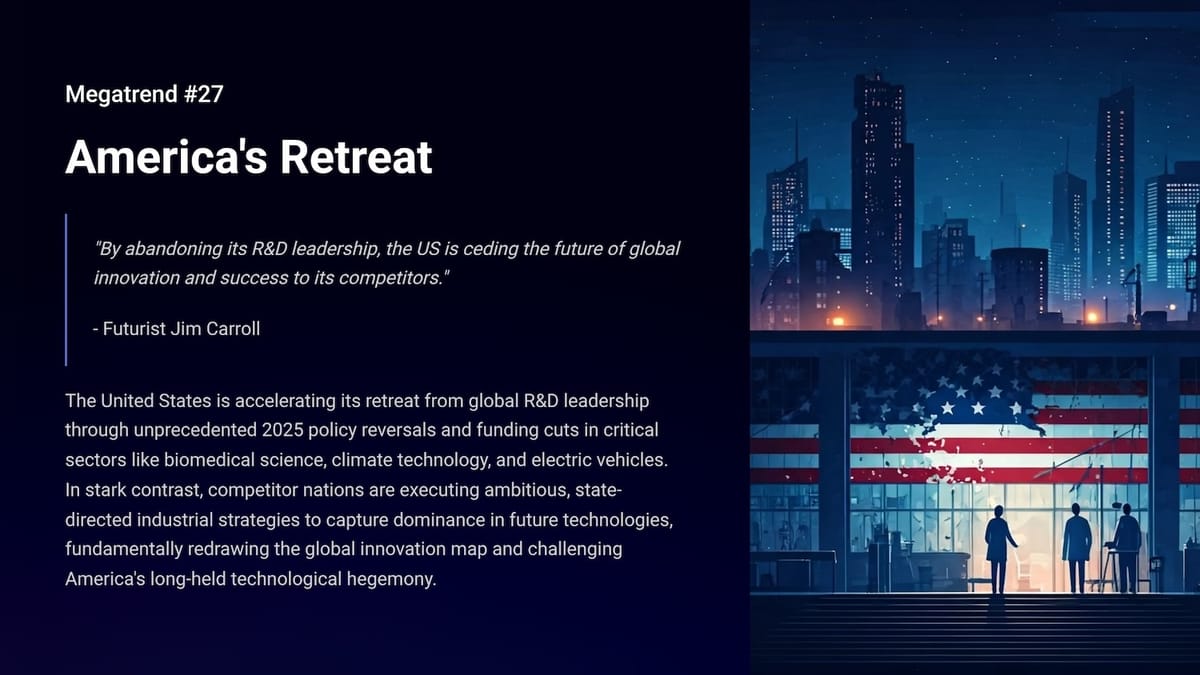"By abandoning its R&D leadership, the US is ceding the future of global innovation and success to its competitors." - Futurist Jim Carroll

(Futurist Jim Carroll is writing a series on 30 Megatrends, which he first outlined in his book Dancing in the Rain: How Bold Leaders Grow Stronger in Stormy Times. The trends were shared in the book as a way of demonstrating that, despite any period of economic volatility, there is always long-term opportunity to be found. The book is now in print - learn more at dancing.jimcarroll.com)
This is a LONG post.
And yet, as one of the most consequential trends of our time, it deserves the attention it gets. You can't write about the biggest trends of the coming decade without acknowledging the massive reversal that is the US right now.
It pains me to write this, but it's pretty clear the United States is accelerating its retreat from global R&D leadership through unprecedented 2025 policy reversals and funding cuts in critical sectors like biomedical science, climate technology, and electric vehicles. In stark contrast, competitor nations are executing ambitious, state-directed industrial strategies to capture dominance in future technologies, fundamentally redrawing the global innovation map and challenging America's long-held technological hegemony.
What does it mean? Oh boy, this is a complicated post. I don't expect I have many followers in the 'other' camp, so let's go back to the post I wrote in 2017, which predicted, with stunning accuracy, where we find ourselves today. "What Comes Next with the Decline of an Empire" took my futurist's mind and applied it to what I saw happening. The original post can be found here. The updated PDF analysis of my predictions, found below, can be found here.

At the time, I was examining the state of the new political environment as it was unfolding - travel bans, attacks on science, and more. I noted, "It's about time someone starts to talk about the future implications of the new world history that we are now watching unfold."
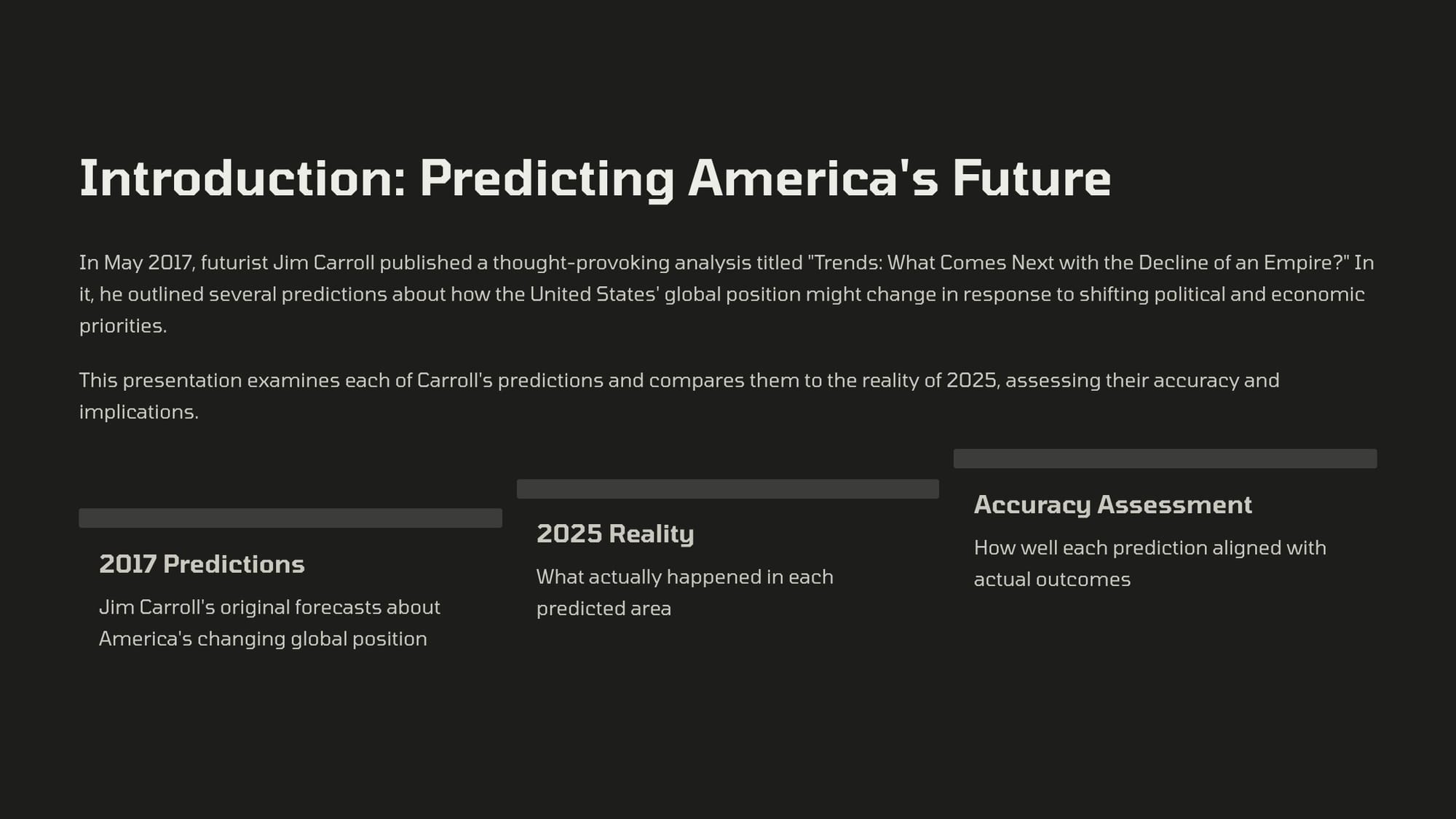
Let's start this post - "America's Retreat" - by examining my 2017 predictions in the light of where we are today in 2025.

I fed each prediction to Google Gemini, asking it to reflect upon its accuracy. My original prediction is printed verbatim.
- 2017 Prediction: Science and R&D relocate. For a long time, the US has been the engine of the global R&D machine, but that is no longer the case. The trend began long before the current era of political discourse – I documented it in a post back in 2008, Revisiting the Hollowing out of Global R&D Trends. But the current anti-science mindset that is percolating throughout the US will only accelerate a trend that is already underway. A good chunk of the pure science research that drives future economic growth won’t occur in the US. That has massive implications for the countries that choose to take advantage of this realignment.
2025 Reality Check: This prediction has proven to be remarkably accurate and is now the central theme of the global innovation landscape. The "anti-science mindset" has manifested in devastating 2025 federal budget cuts, including a 57% reduction for the National Science Foundation, a 37% proposed cut for the National Institutes of Health (NIH), and the complete closure of the EPA's research office. This has accelerated a trend that was already in motion: the U.S. share of global R&D spending has fallen from nearly 40% in 2000 to under 31%, while China's has surged from less than 5% to over 24%. When adjusted for cost efficiency, China's effective R&D investment is now approximately $1.8 trillion, more than double the U.S. total of $823 billion, indicating that leadership in pure research activity has already shifted.
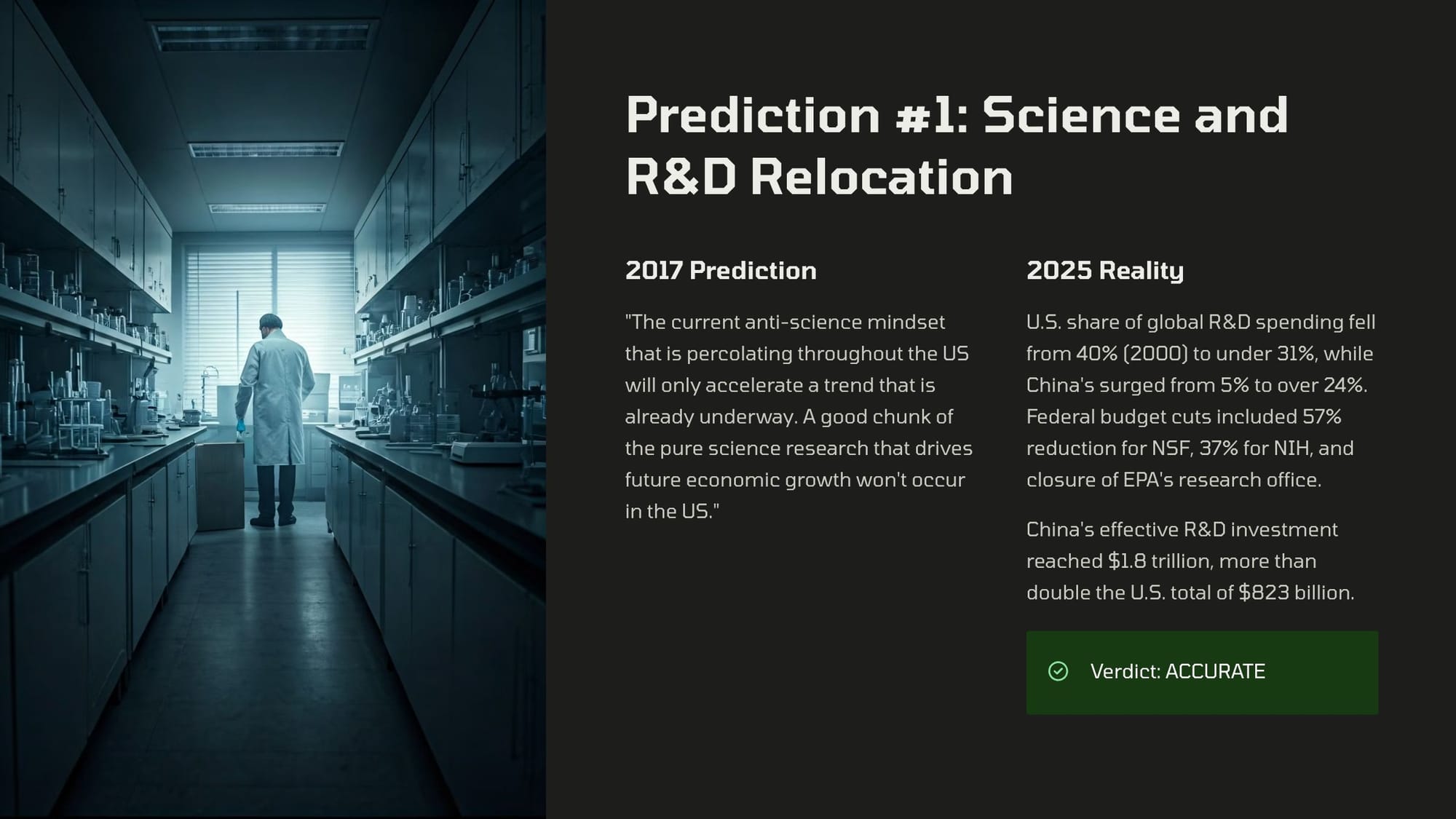
- 2017 Prediction: Energy and green industries invest where it matters. There can’t be a more exciting industry — next to advanced manufacturing — than what is happening with wind, solar, and other forms of energy generation. Exponential science is driving exponential change. Yet if you make a decision not to align yourself with the fast innovation trends that are unfolding, you miss out on the jobs, growth, and new companies that are appearing in this space. I expect that many companies in this sector will make economic development decisions that are influenced by an attitude that welcomes their innovation.
2025 Reality Check: This prediction has been validated by a stark divergence in global strategy. The U.S. has actively decided not to align with these trends, withdrawing from the Paris Agreement and systematically dismantling the policy framework for electric vehicles (EVs), including tax credits and emissions standards. As a direct result, investment and leadership have gone elsewhere. China and the EU have stepped into the leadership vacuum, with China now dominating key green technologies, controlling over 75% of global lithium-ion battery manufacturing and nearly 80% of solar module production. Germany's "Energiewende" strategy has positioned it as a leader in green hydrogen and renewables. The U.S. retreat has ceded leadership in what is projected to be a $2 trillion market by 2035.

- 2017 Prediction: Travels shift. Immigration bans, an increasing climate of hatred, the degradation of a climate of diversity, and laptop bans. Quite simply, a greater percentage of the world’s population will choose to visit other parts of the world. The laptop ban itself causes the mind to boggle. Why would anyone encourage people to spend hours travelling in a massively unproductive environment when they could choose to go elsewhere?
2025 Reality Check: The predicted shift in travel has materialized most acutely in the scientific community. The unwelcoming policy environment, combined with severe funding instability, has created a quantifiable "brain drain." European research institutions reported a 35% increase in applications from U.S.-based scientists in early 2025 alone. This confirms that not only are tourists and business travelers reconsidering, but the world's top scientific talent is actively choosing to go elsewhere.
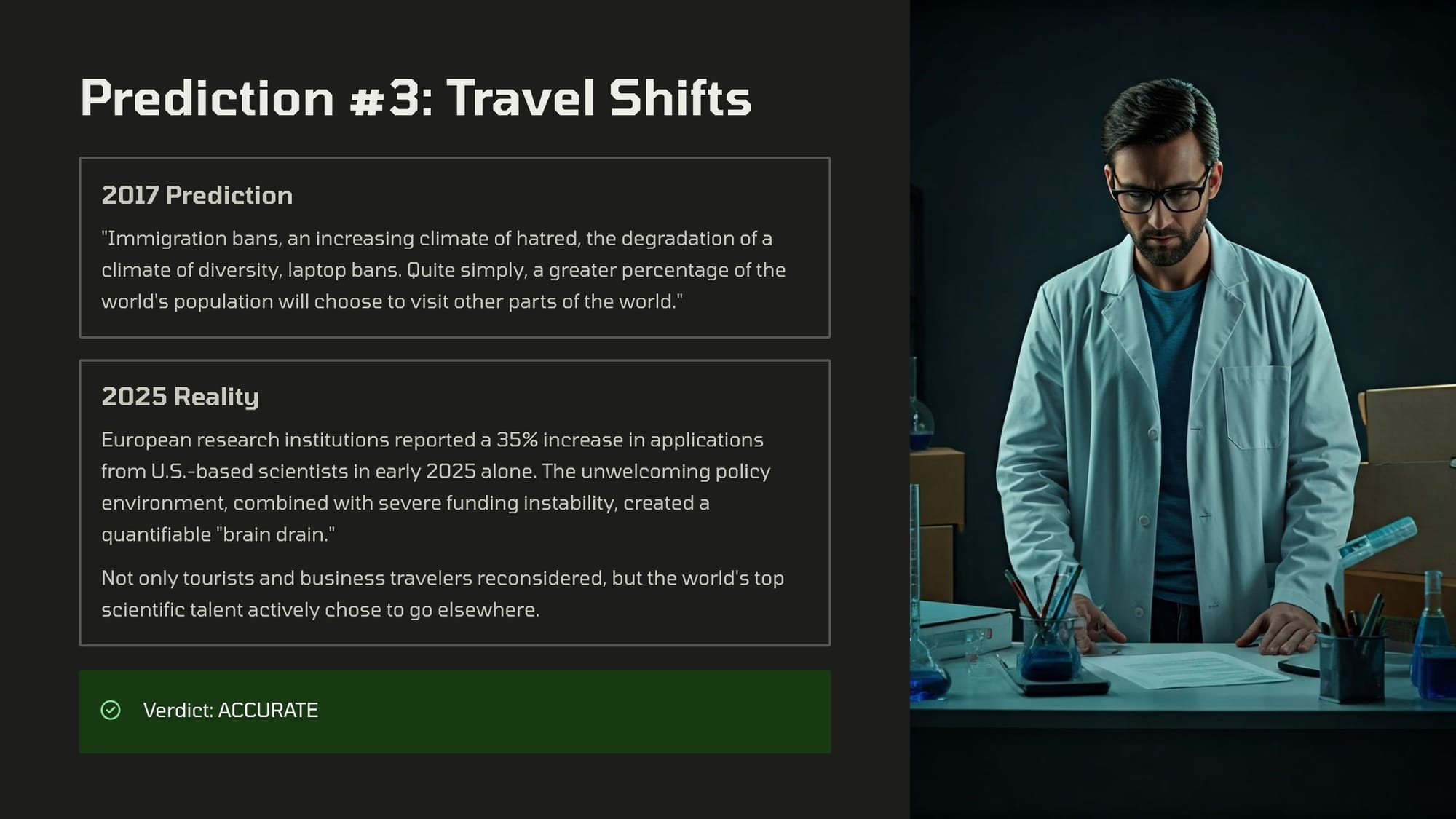
- 2017 Prediction: Meetings and events relocate. The global meeting industry generates billions of dollars in economic activity. Quite simply, countless scientific and other conferences and events will choose to host future events in a more tolerant, idea diverse location than the US. Meeting professionals understand this, but few are willing to listen.
2025 Reality Check: While comprehensive data on event relocation is diffuse, the underlying drivers of this prediction have intensified. The "brain drain" of scientists and the U.S. withdrawal from international scientific bodies like the IPCC create a less central role for the U.S. in global scientific discourse. With top talent and research funding migrating to Europe and Asia, it is a logical consequence that the major gatherings that follow that talent and funding will increasingly be hosted in those more welcoming and resource-rich locations.
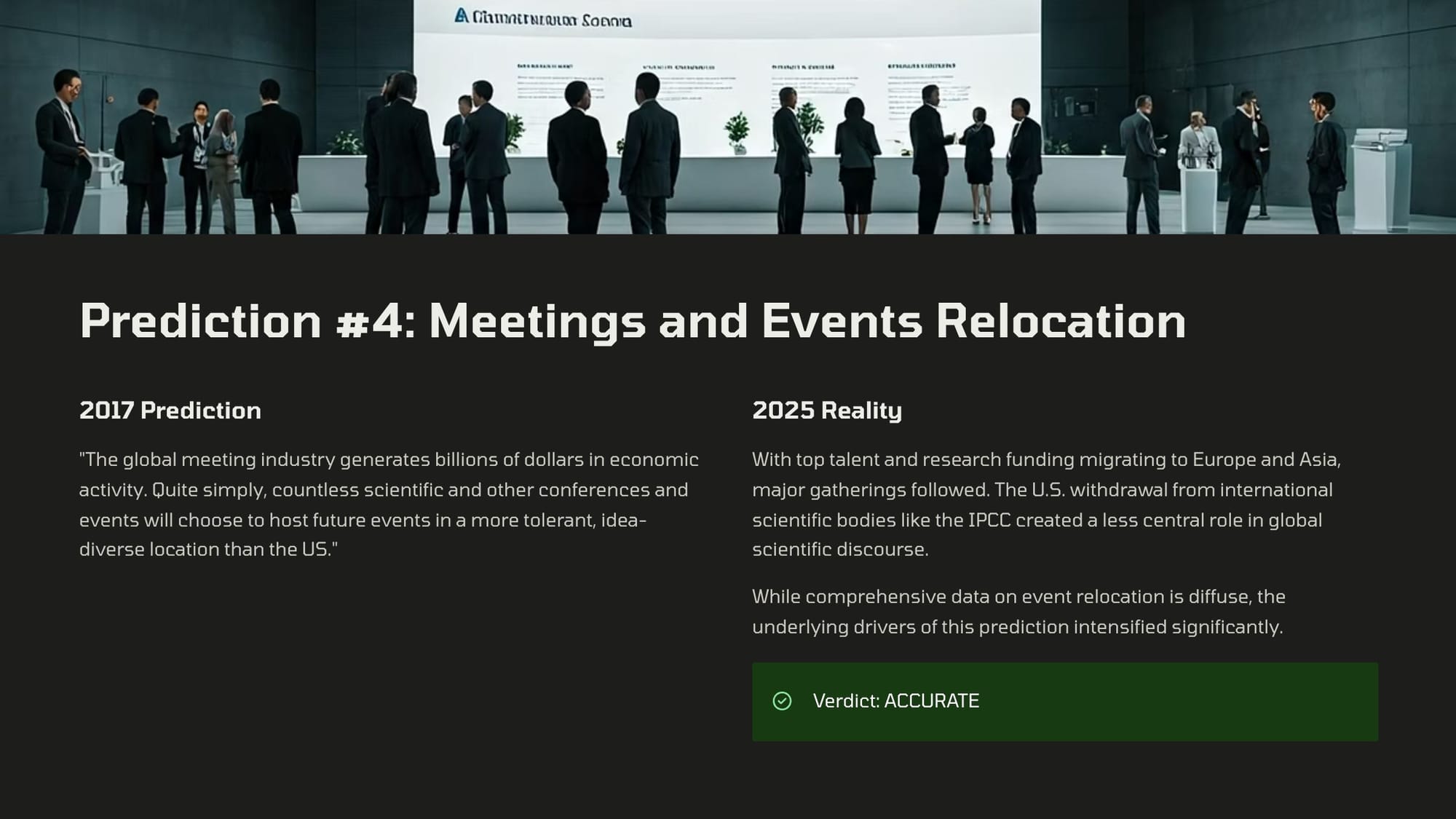
- 2017 Prediction: Sporting events move. I have a friend who has just been appointed to take a senior role at the Canadian Soccer Association. He has the initiative to pursue the hosting of a future World Cup event with a combined bid involving Canada, the US, and Mexico. Think about the chances of that happening in the current climate. Like, it won’t.
2025 Reality Check: This specific example proved to be an outlier, as the joint bid for the 2026 FIFA World Cup was successful. However, it stands in contrast to the overwhelming accuracy of the other predictions. The success of the bid may be attributed to the long-term, globally integrated nature of sporting organizations, which can sometimes operate on a different track than immediate geopolitical shifts. Nonetheless, the broader prediction about the U.S. becoming a less attractive global partner has been borne out in the realms of science, technology, and climate policy.

- 2017 Prediction: Minds that matter move. If I were a PhD candidate, where might I choose to place the efforts of my mind today? Into an environment in which ideas matter! We are living in a modern-day era of Atlas Shrugged. Who is John Galt? He and she are out there, and they are making their decision.
2025 Reality Check: The "Atlas Shrugged" scenario is unfolding. The NIH funding cuts have disproportionately impacted early-career researchers, creating what observers have termed a "lost generation of scientists". In response, competitor nations have launched aggressive, well-funded campaigns to recruit this exact demographic, such as Canada's "Canada Leads 100 Challenge" and Australia's "Global Talent Attraction Program". The minds that matter are not just moving; they are being actively poached by countries that have created environments where their ideas are valued and funded.
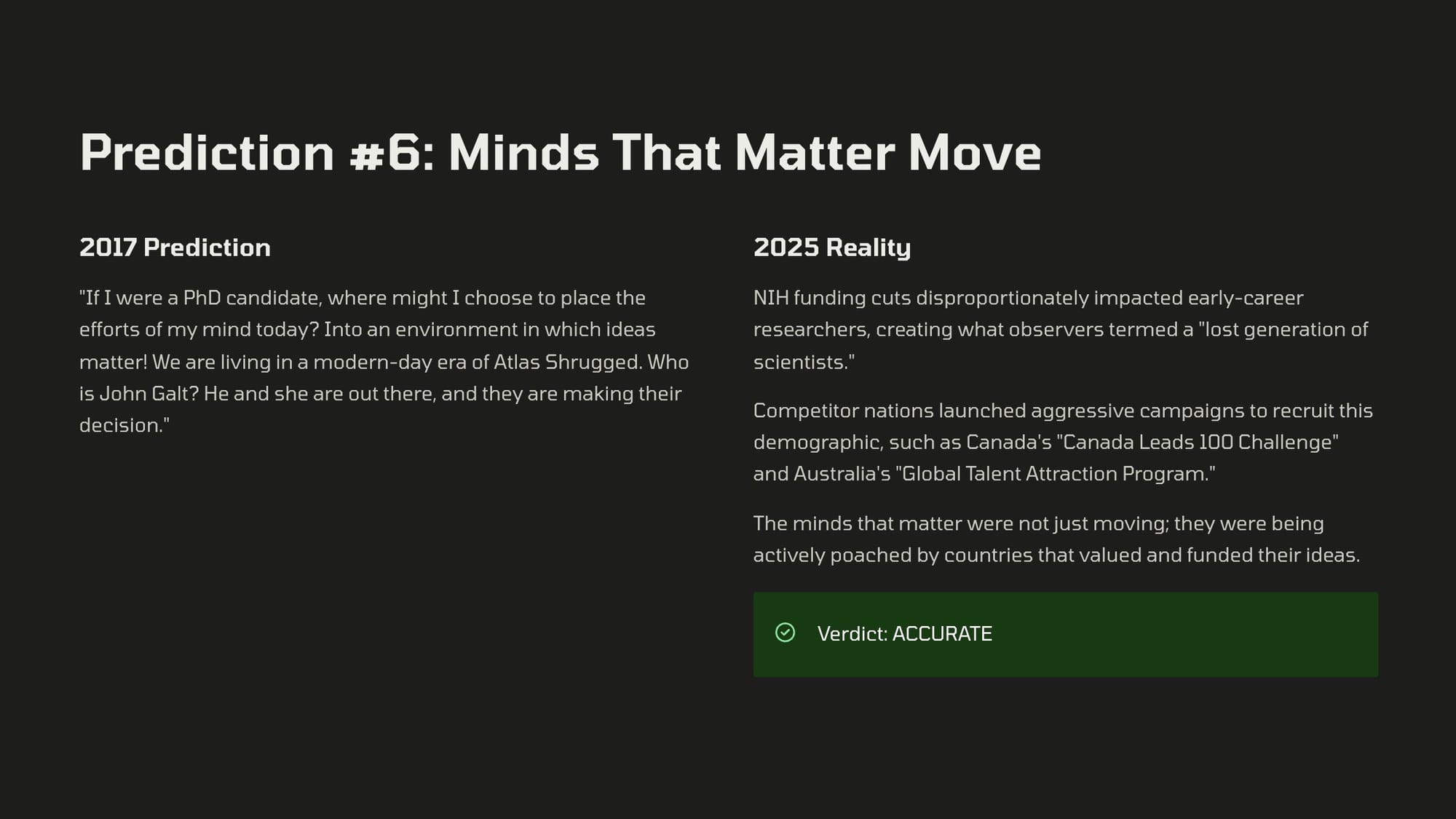
- 2017 Prediction: Skills training evaporates. Economies move forward by enhancing the skills of their participants. The world of manufacturing provides the perfect example: dead-end brute force manufacturing jobs are gone, and they aren’t coming back. Robotics, digitization, 3D printing, and more define the future, all of which involve higher-level skills and education. Countries worldwide are racing to enhance the skills of their workforce. This will slow down in the US, given the current environment. The eventual winners embrace new skills; the losers cling to old, outdated, irrelevant skills.
2025 Reality Check: The competitive gap in skills training has widened dramatically. While the U.S. has focused on deregulation, competitor nations have integrated massive human capital and skills development programs into their national strategies. Germany's High-Tech Strategy 2025 has a huge focus on aligning education and training with technological change. South Korea is investing heavily to cultivate top talent in AI and other strategic fields, and Japan's innovation strategy is built on developing human resources.
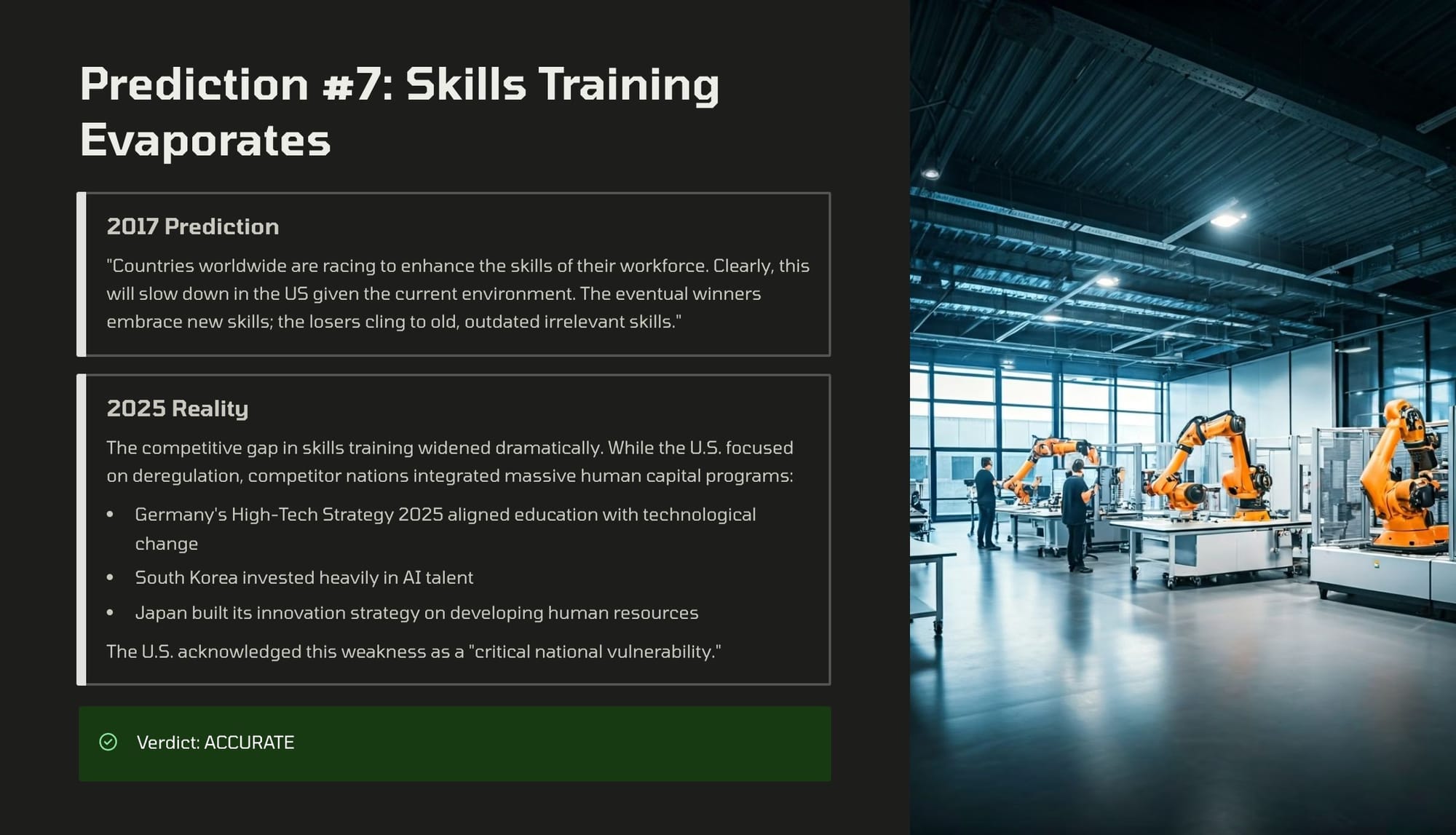
- 2017 Prediction: The U.S. loses its dominance. This morning, I came across a really interesting Tweet that mentioned a Greek engineer who chose to move to Eindhoven in the Netherlands, considered to be one of Europe’s “Silicon Valleys.” In years past, that fellow might have moved to the US, turned on his mind, and created the future, growth, and jobs. That era is coming to an end. The implications are profound. For the last 50 years, the California IT engine has dominated the accelerated innovation that comes from technology. That’s now changing quickly: the new growth engines are “Silicon Wadi” in Israel, the Shenzhen Hi-Tech Industrial Park in China, and Canada’s Technology Triangle centred on Kitchener. They are set to take momentum and innovation away from Silicon Valley as America loses its dominance in one of the key drivers of innovation success, technological innovation.
2025 Reality Check: This prediction has fully materialized. The era of singular U.S. dominance is over, replaced by a multipolar innovation world. This report details the rise of the exact competitors forecasted: China's state-driven "Made in China 2025" has turned Shenzhen into a global powerhouse; Israel's "Silicon Wadi" has evolved into a "Scale-Up Nation" with the world's highest R&D intensity; and nations like South Korea and Germany are executing highly focused national strategies to dominate specific high-tech sectors. The momentum has indeed shifted.
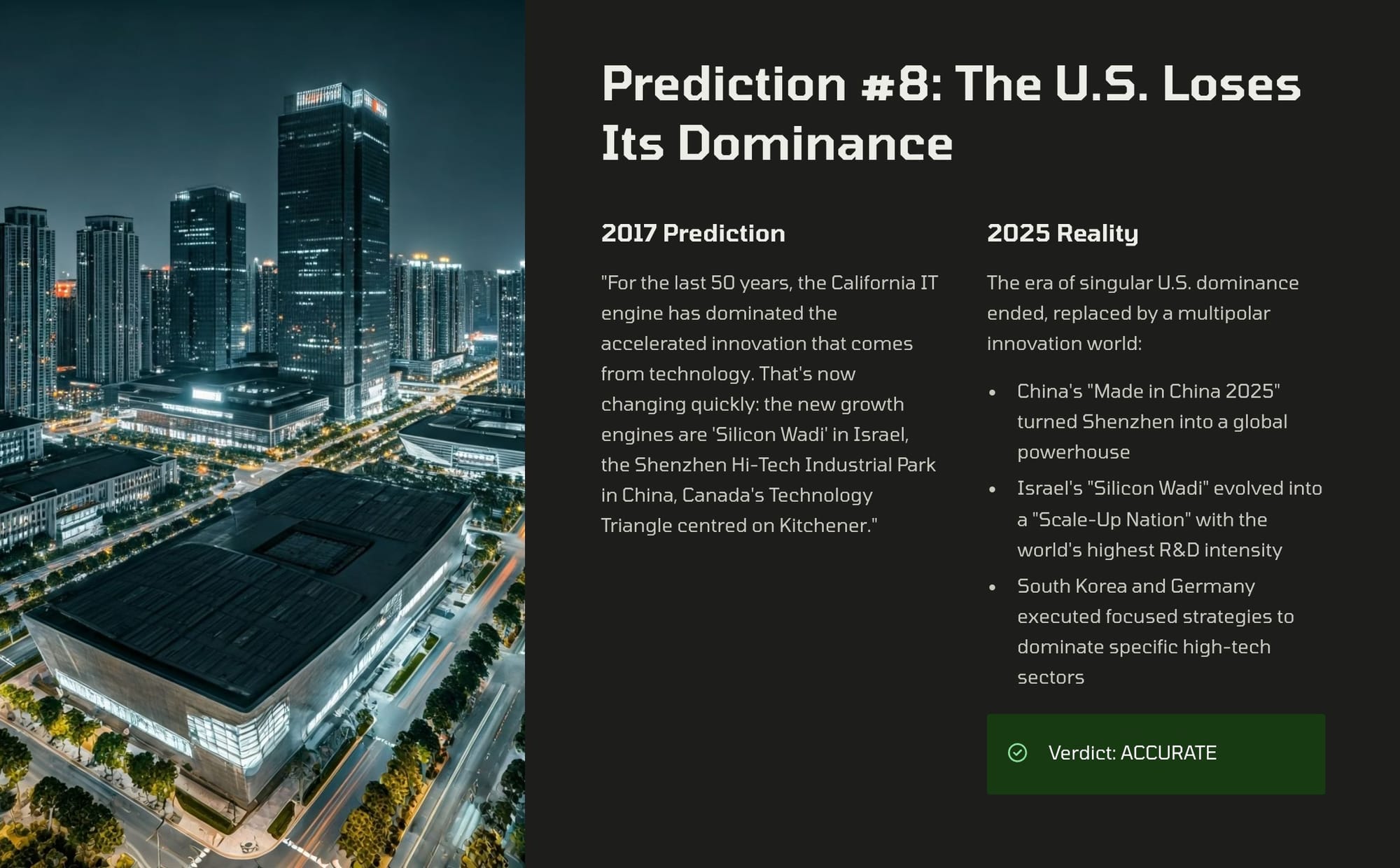
- 2017 Prediction: New multinationals become the corporate model. The US Fortune 500 has dominated the global economy for a long time, but if you take all of these trends, growth will occur elsewhere. Companies will choose to realign themselves to growth. The new Fortune 500s will be headquartered in Germany, Singapore, China, and elsewhere. As corporate office power shifts, so too goes economic growth.
2025 Reality Check: The rise of non-U.S. multinationals is a direct consequence of these trends. In EVs, China's BYD has become a global force. In telecommunications, Huawei has achieved massive scale. In green technology, Germany's Siemens has leveraged the "Energiewende" to become a world leader. In semiconductors and electronics, South Korea's Samsung is a dominant player. While the Fortune 500 has not been completely rewritten, these state-backed national champions are the new face of global corporate power, built on the R&D and industrial strategies the U.S. has largely abandoned.
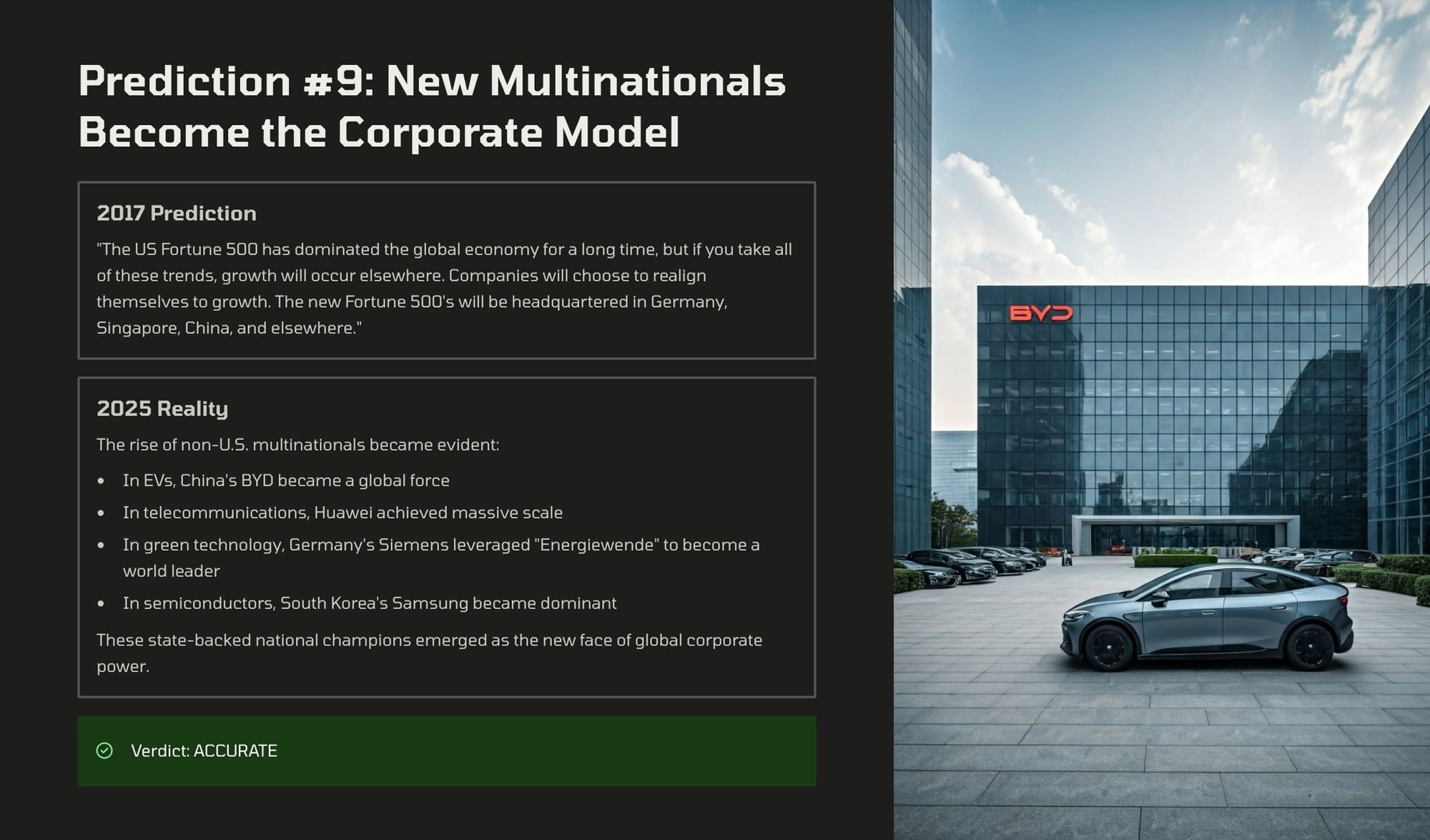
- 2017 Prediction: Political discourse matures elsewhere. Long the beacon of democracy, it seems we are witnessing its decline. Advanced economies are having discussions about the reality of climate change, skills retraining, and more. Temper tantrums don’t define future success; mature discussions do.
2025 Reality Check: The report highlights a stark contrast in political approaches. The U.S. is described as being engaged in a "debilitating internal tug-of-war" with a "politically volatile approach to industrial policy" that creates "strategic incoherence." This stands in sharp opposition to the "long-term, state-directed, and heavily funded industrial strategies" of its primary competitors.
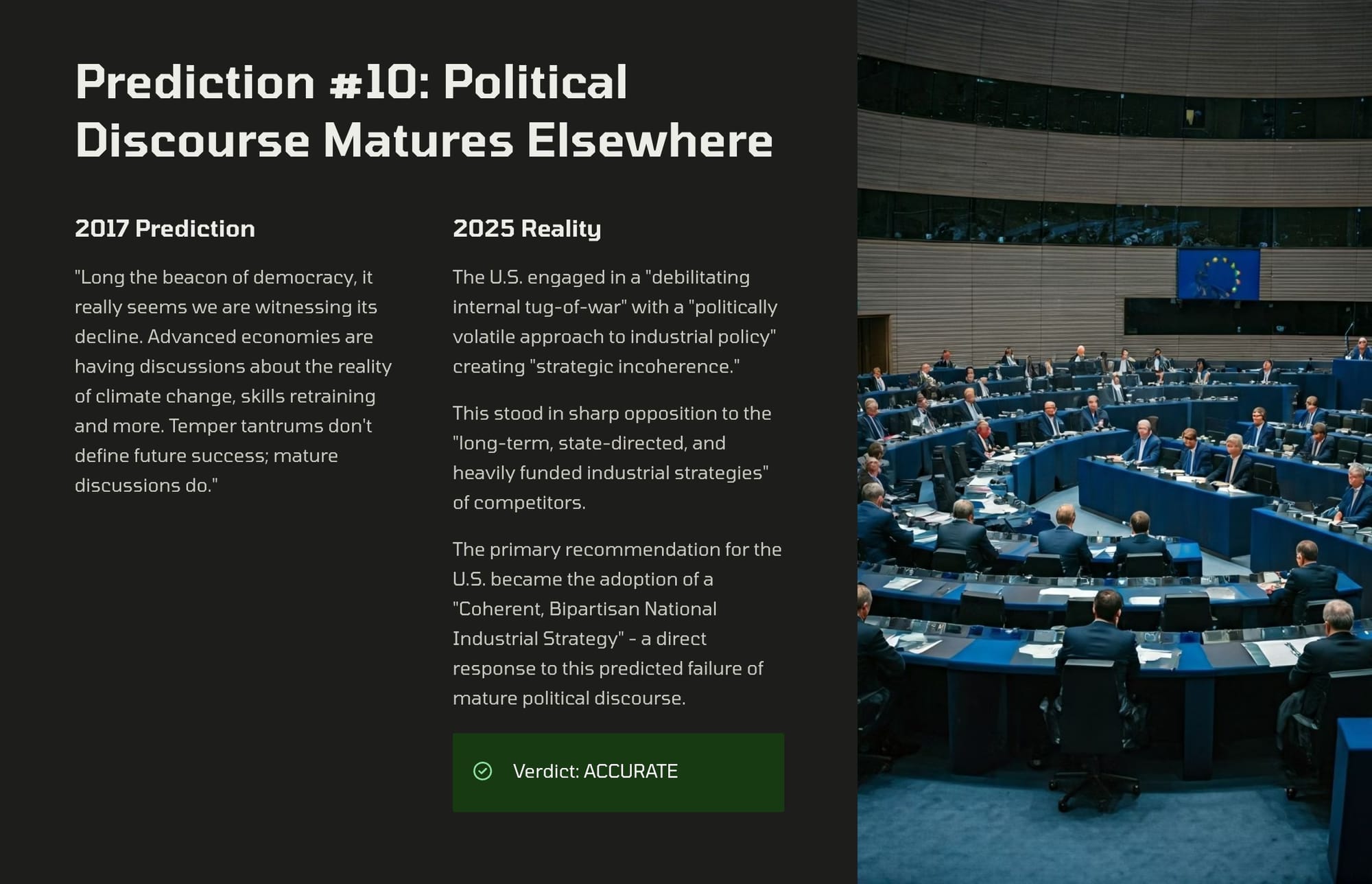
So overall, how did I do?
Sadly, all too well. 9 of the 10 predictions were entirely accurate. As Google notes, "Carroll's predictions about the shifting global landscape proved to be remarkably prescient."

I only got the sporting event prediction wrong. But hey, the World Cup is in 2026, and organizers are already expressing alarm about ICE raids on teams and fans, so I might still be proven right.
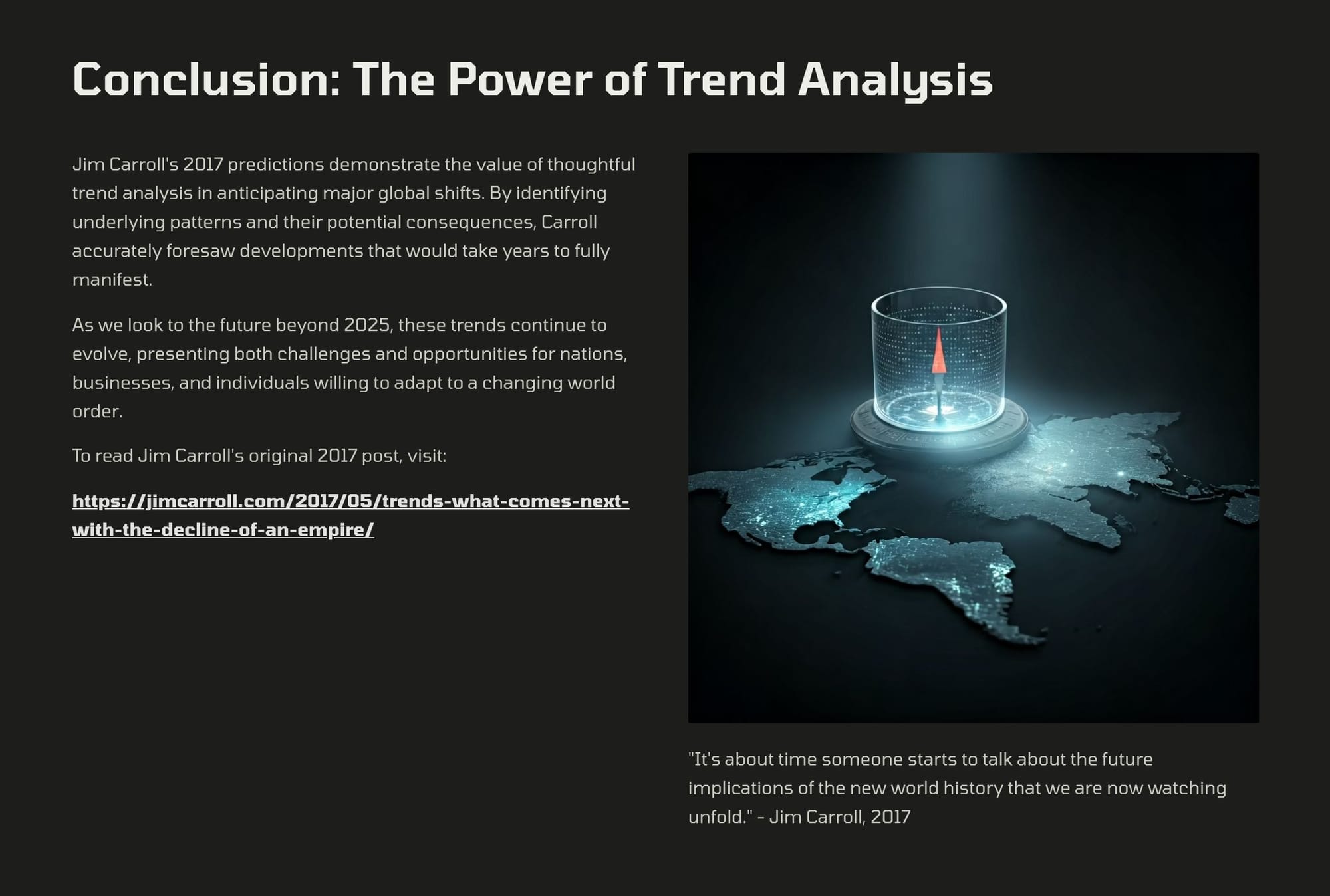
So what are the implications of this type of retreat? Let's dig in further. I took a look at how this will accelerate the global innovation power shift. Put this in the context of the R&D trend. The fact is, this retreat threatens America's technological leadership and creates opportunities for competitor nations. Here's a full PDF that dives right in, but I'll summarize it below.
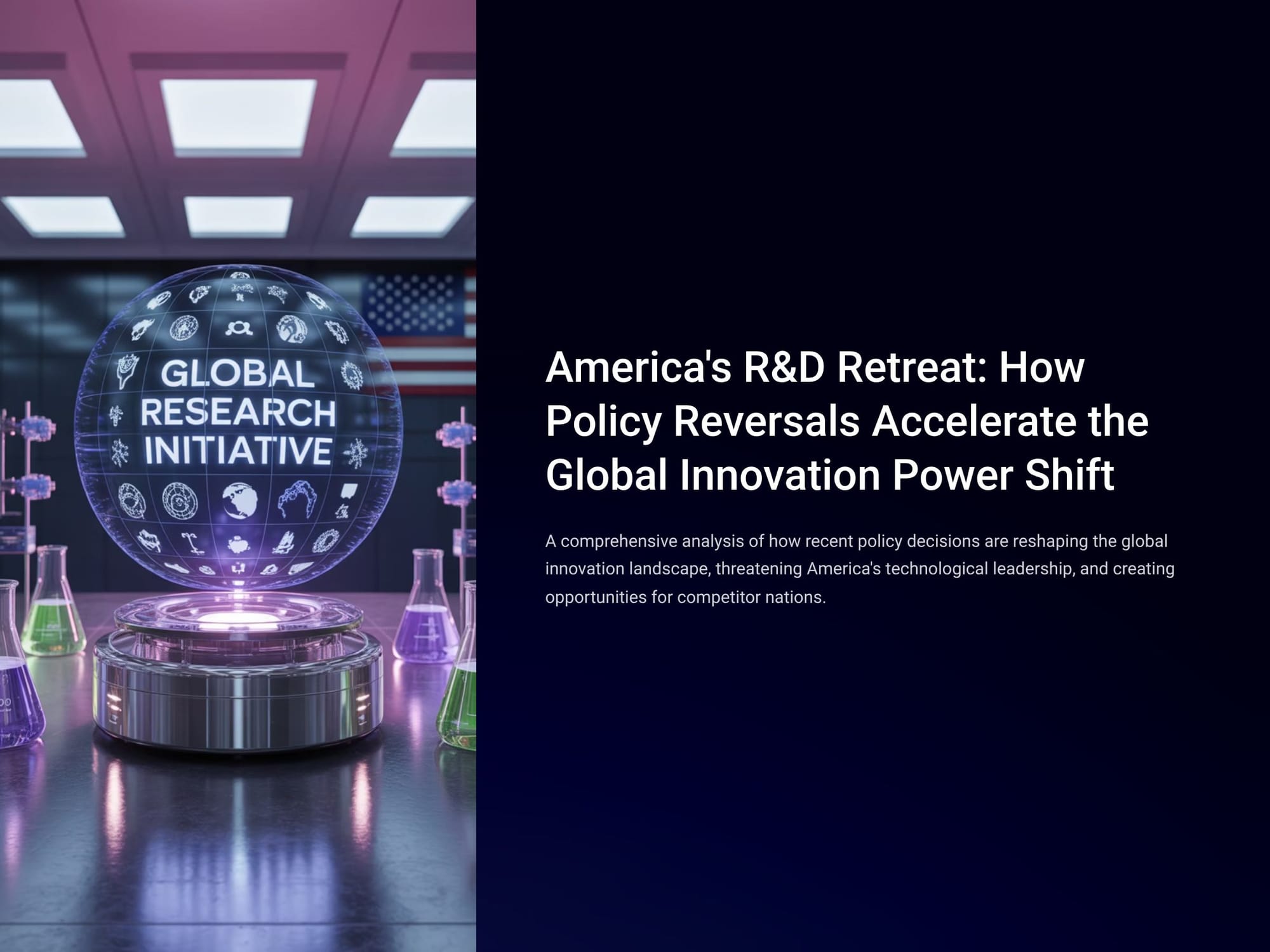
How bad is it? Pretty bad.
In absolute terms, the United States remains the world’s largest R&D spender with approximately $823 billion in 2023.
However, this masks a troubling reality - some basic numbers put in perspective the reality of the shift:
- 1.7% US R&D Growth. The growth rate of U.S. R&D spending has slowed significantly in 2023.
- vs. 8.7% China's R&D Growth. China's R&D expenditure surged in the same period, continuing a multi-decade trend of aggressive investment.
- $781B China's Total. China's total R&D spending is rapidly closing the gap with the United States.
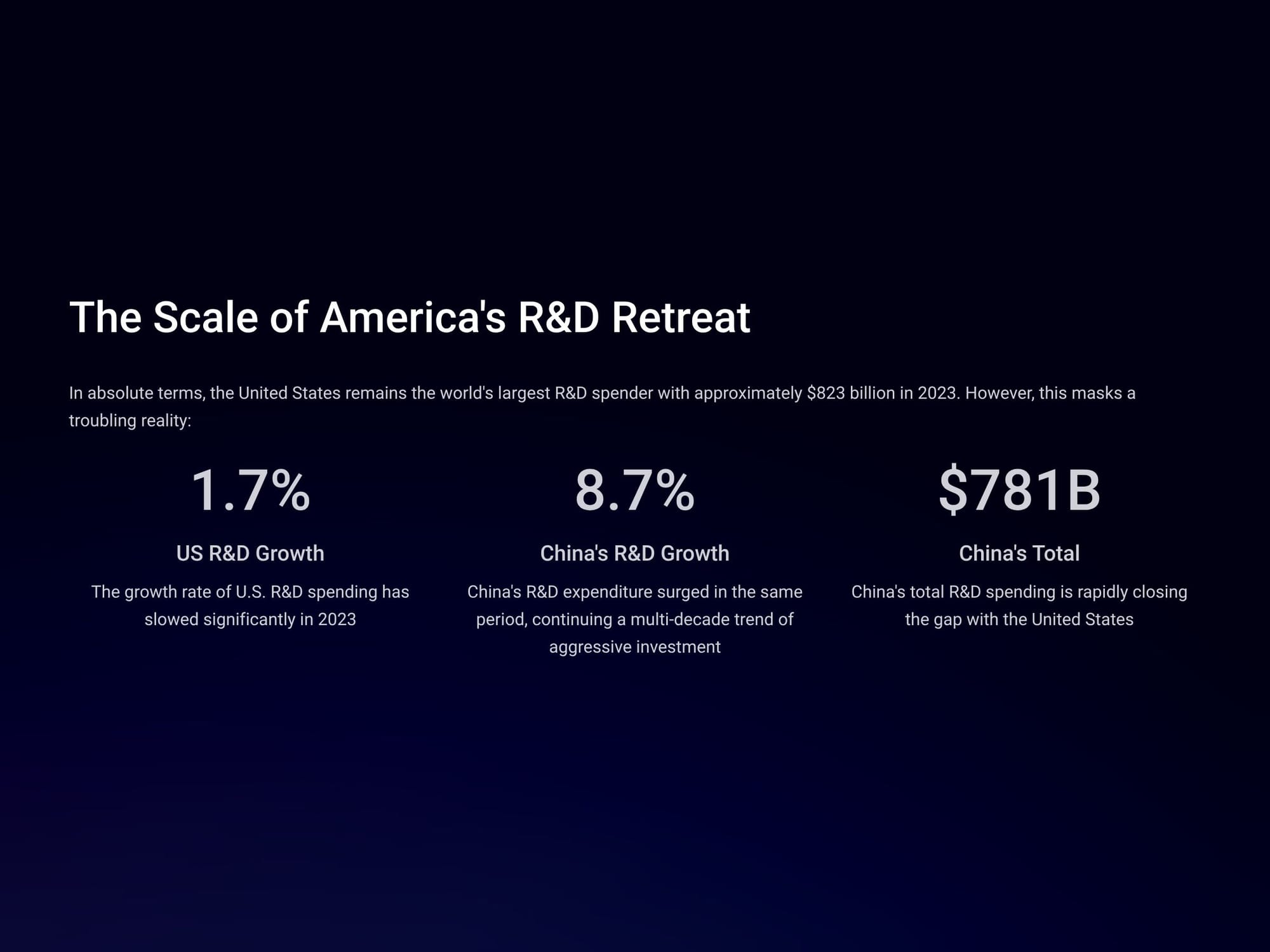
Since 2000, the U.S. share of global R&D has declined significantly, while China's share has exploded, fundamentally altering the innovation landscape.
- 2000: U.S. share of global R&D: nearly 40%. China's share of global R&D: less than 5%.
- 2023: U.S. share of global R&D: just under 31%. China's share of global R&D: over 24%.
- 2030 (Projected): China is likely to overtake the US in absolute R&D spending.
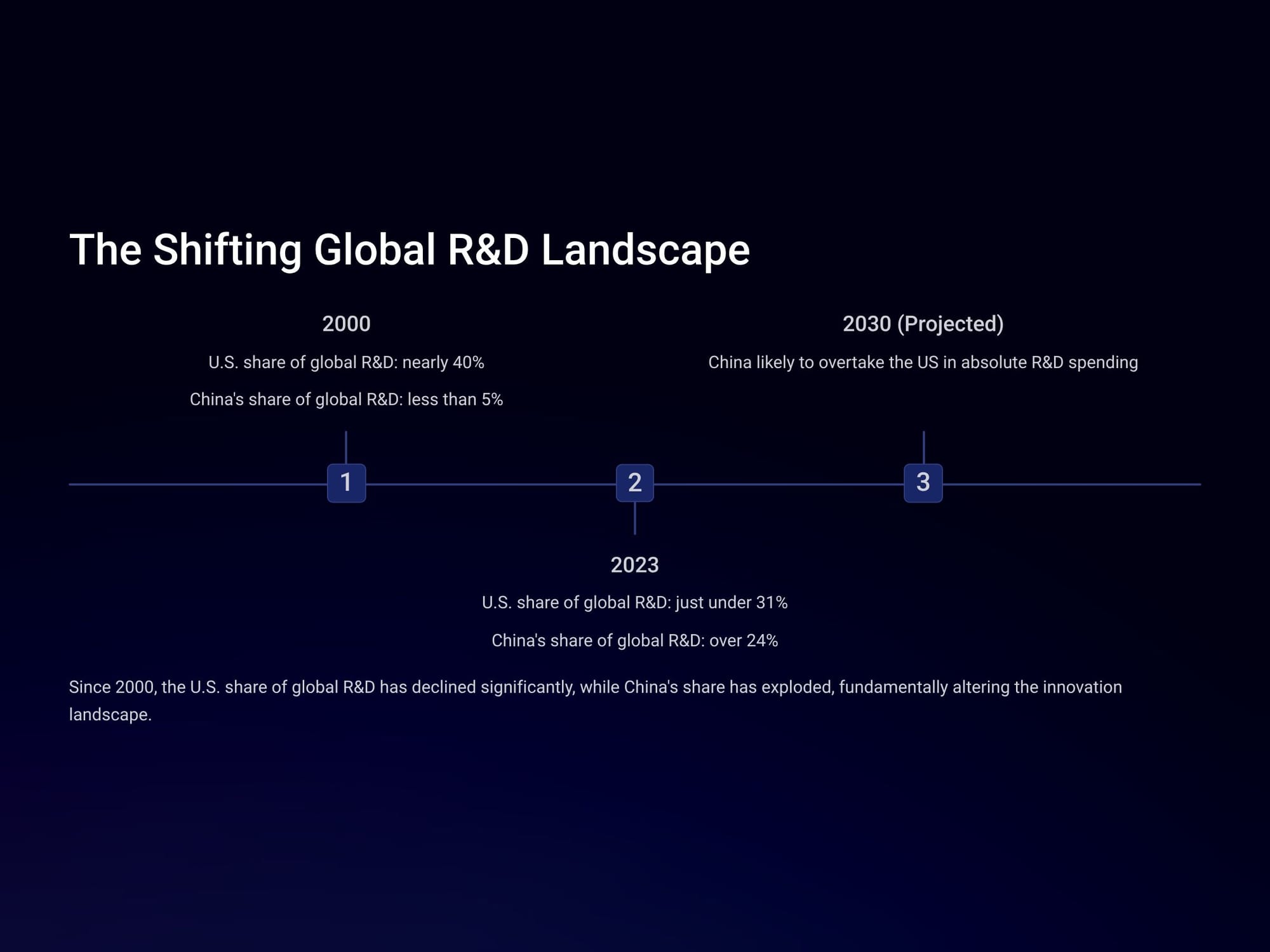
The decline in U.S. R&D leadership is being actively accelerated by the 2025 policy avalanche, representing the steepest decline in federal science funding since 2013:
- National Science Foundation (NSF). 57% budget reduction from $9 billion to $3.9 billion. Hundreds of employees have already been laid off.
- National Institutes of Health (NIH). $2.3 billion reduction in new grant awards. Proposed FY 2026 restructuring calling for a 37% budget cut.
- Environmental Protection Agency (EPA). The Office of Research and Development is facing complete closure. Affecting 1,155 scientists and eliminating federal environmental science capacity.
- Department of Energy. 24 clean energy projects worth $3.7 billion cancelled. Proposed a 74% reduction to the Office of Energy Efficiency and Renewable Energy.
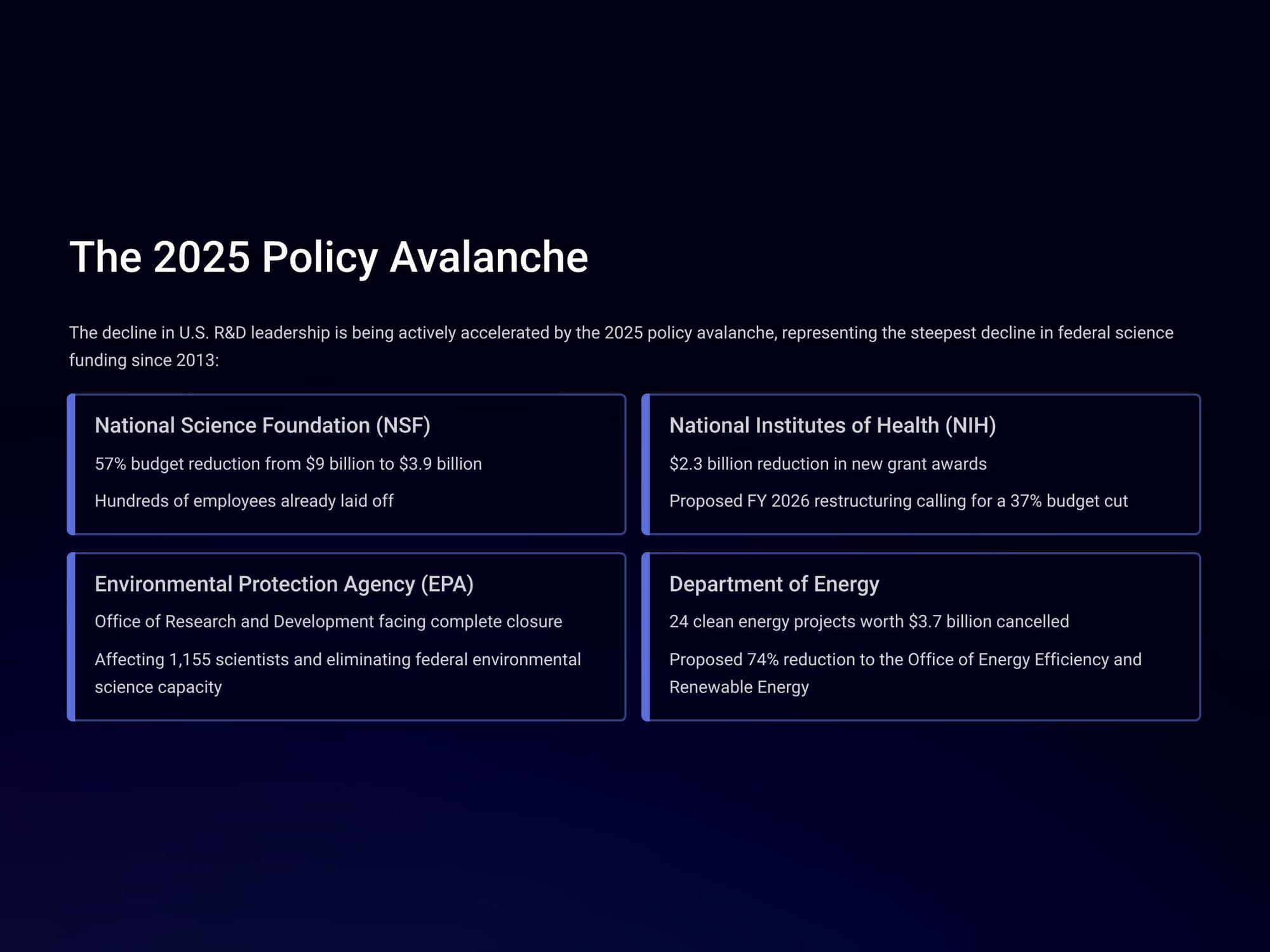
The erosion of America's R&D leadership is being actively accelerated by domestic policy reversals in three critical sectors:
- Biomedical Science: Unprecedented cuts to NIH funding and research grants.
- Climate Technology: Formal disengagement from international climate science initiatives.
- Green Mobility: Systematic dismantling of EV policy framework.

The war on biomedical science? The U.S. biomedical research infrastructure is facing an unprecedented assault:
- NIH canceled over $1.9 billion in research grants, affecting more than 1,400 peer-reviewed proposals.
- New cap of 15% on indirect cost rates for grants, replacing negotiated rates that typically ranged from 25% to 70%.
- Creation of a "lost generation of scientists" and a quantifiable "brain drain".
- European research institutions are reporting a 35% increase in applications from U.S.-based scientists.
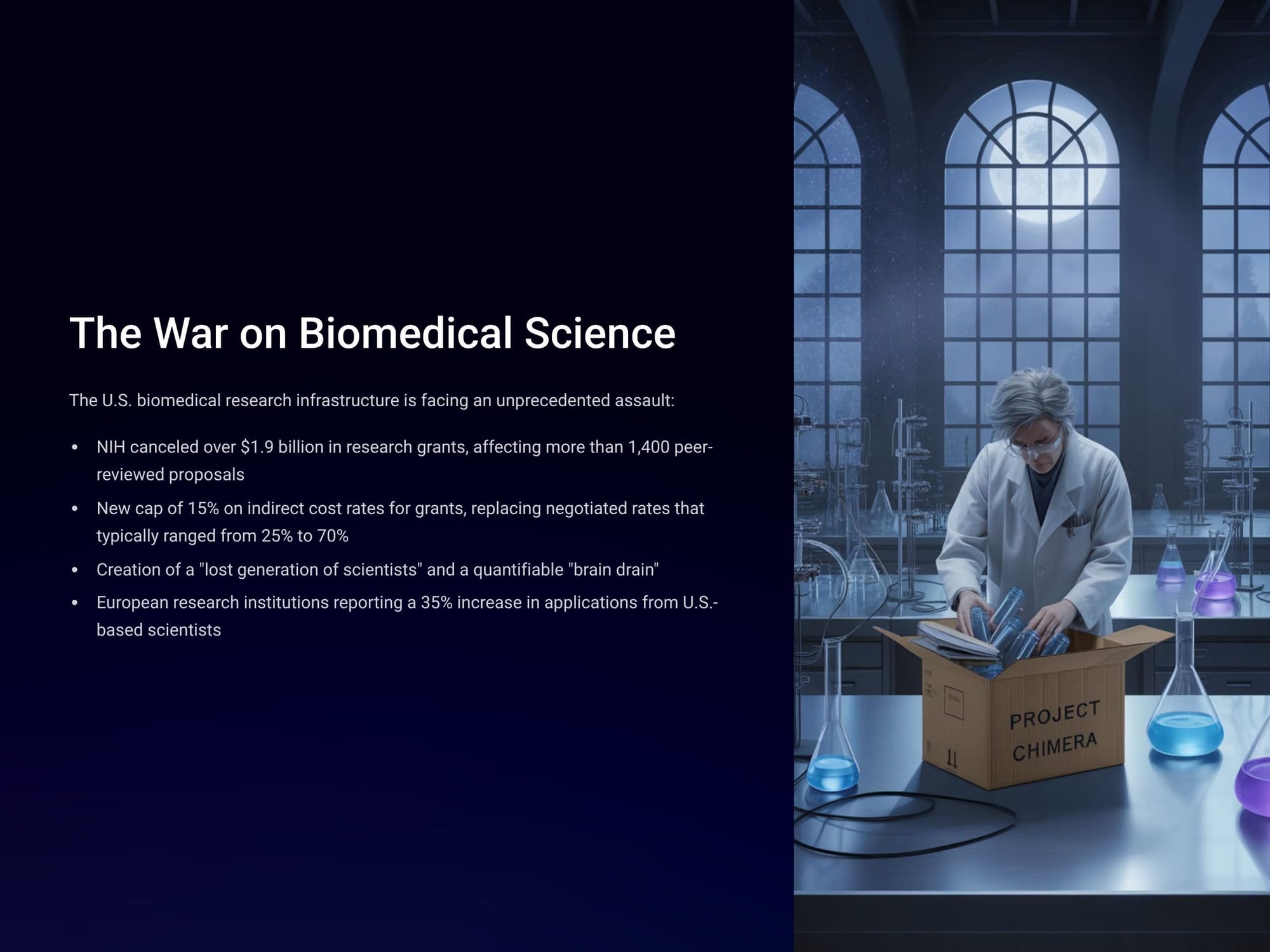
How about the impact on medical innovation? The disruption to translational science is projected to create a 5 to 10-year delay in the development of new therapeutics and diagnostics. This delay will have profound consequences for patients awaiting breakthrough treatments and for America's competitive position in the global biomedical industry.
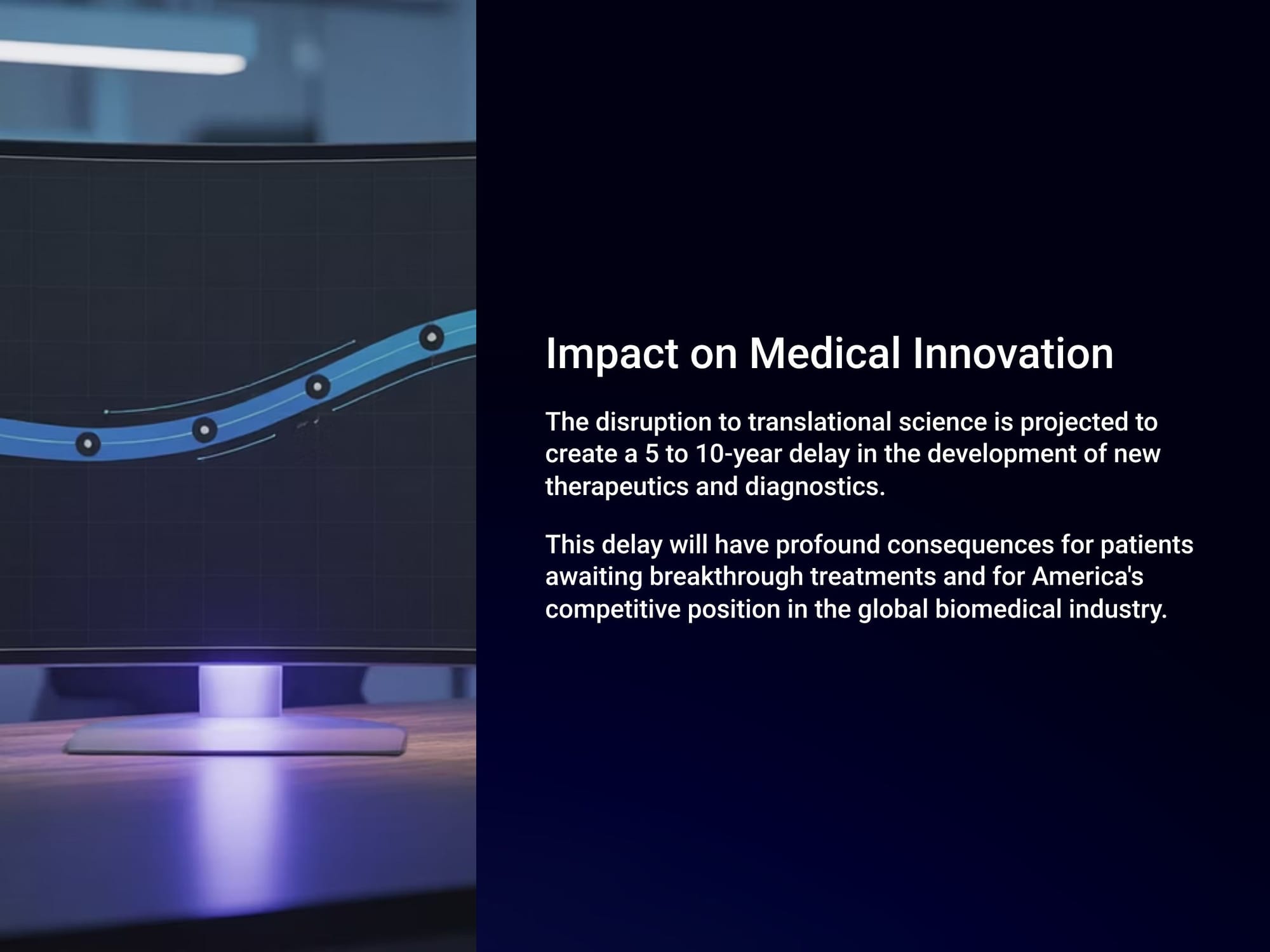
Then there is the complete and utter abdication from climate leadership, it seems simply because someone doesn't like windmills. The result is that the United States has initiated a formal disengagement from international climate science, creating a leadership vacuum in global climate research and policy.
- Paris Agreement Withdrawal: Formal disengagement from international climate science, formalized through a January 2025 executive order.
- Financial Disengagement: Cessation of all financial contributions, notably to the Green Climate Fund.
- Reputational Damage: Significant harm to the nation's scientific credibility and leadership position.
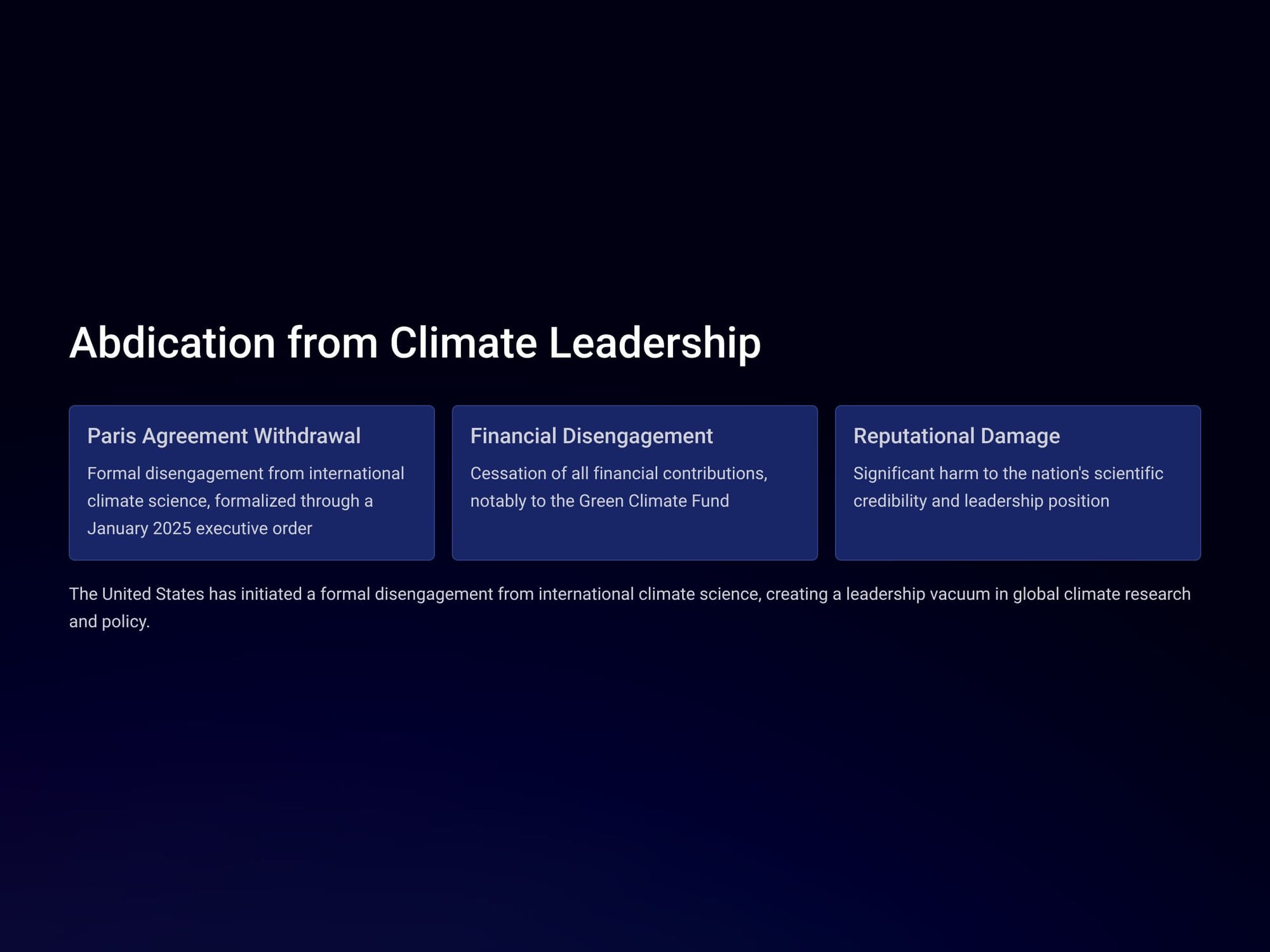
What are the economic consequences of climate disengagement? It's a significant "economic and technical lag" as the U.S. loses access to the latest research driving innovation in the clean energy sector, a market projected to reach over $2 trillion by 2035. China and the European Union have explicitly stepped into the void, issuing a joint statement vowing to lead the global effort in climate science and technology development.
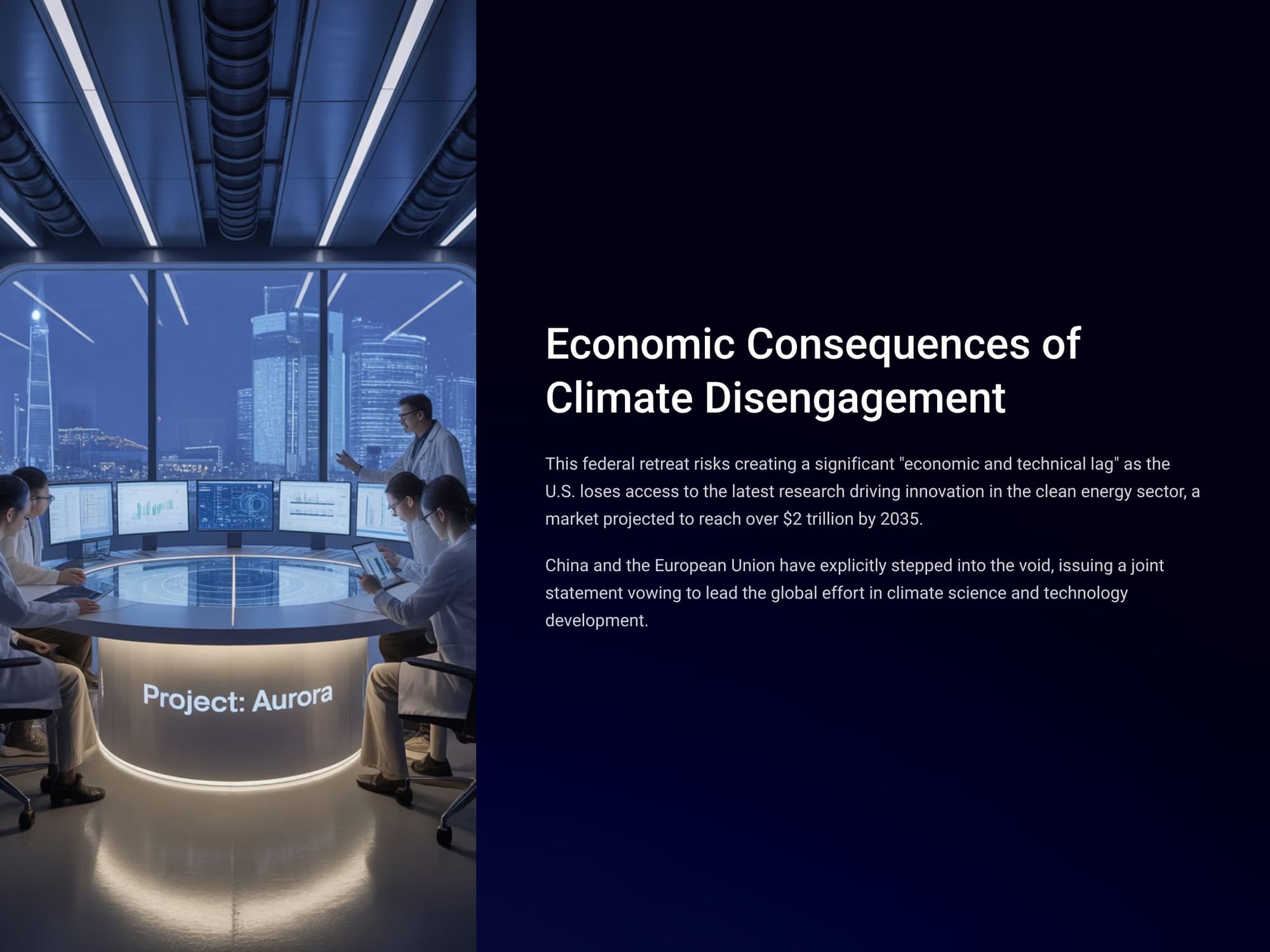
Then there is the fact that EV investment is at risk. U.S. investments in EV and battery manufacturing had reached $199 billion, with $125 billion of that announced in the two years following the passage of the Inflation Reduction Act (IRA)—the very policy framework now being dismantled. This abrupt reversal has created domestic sovereign risk, sending a chilling signal to global investors that U.S. industrial policy is subject to radical, politically-motivated reversals. (D'oh)

And the simple fact is, this is damage that is likely to last decades, as the window for an effective response is narrowing rapidly. The 2025 policy reversals occur precisely when competitors are deploying sophisticated strategies with massive financial commitments. Each year of delay compounds the challenge of reclaiming leadership, as competitor nations build momentum and establish dominance in key technology domains.
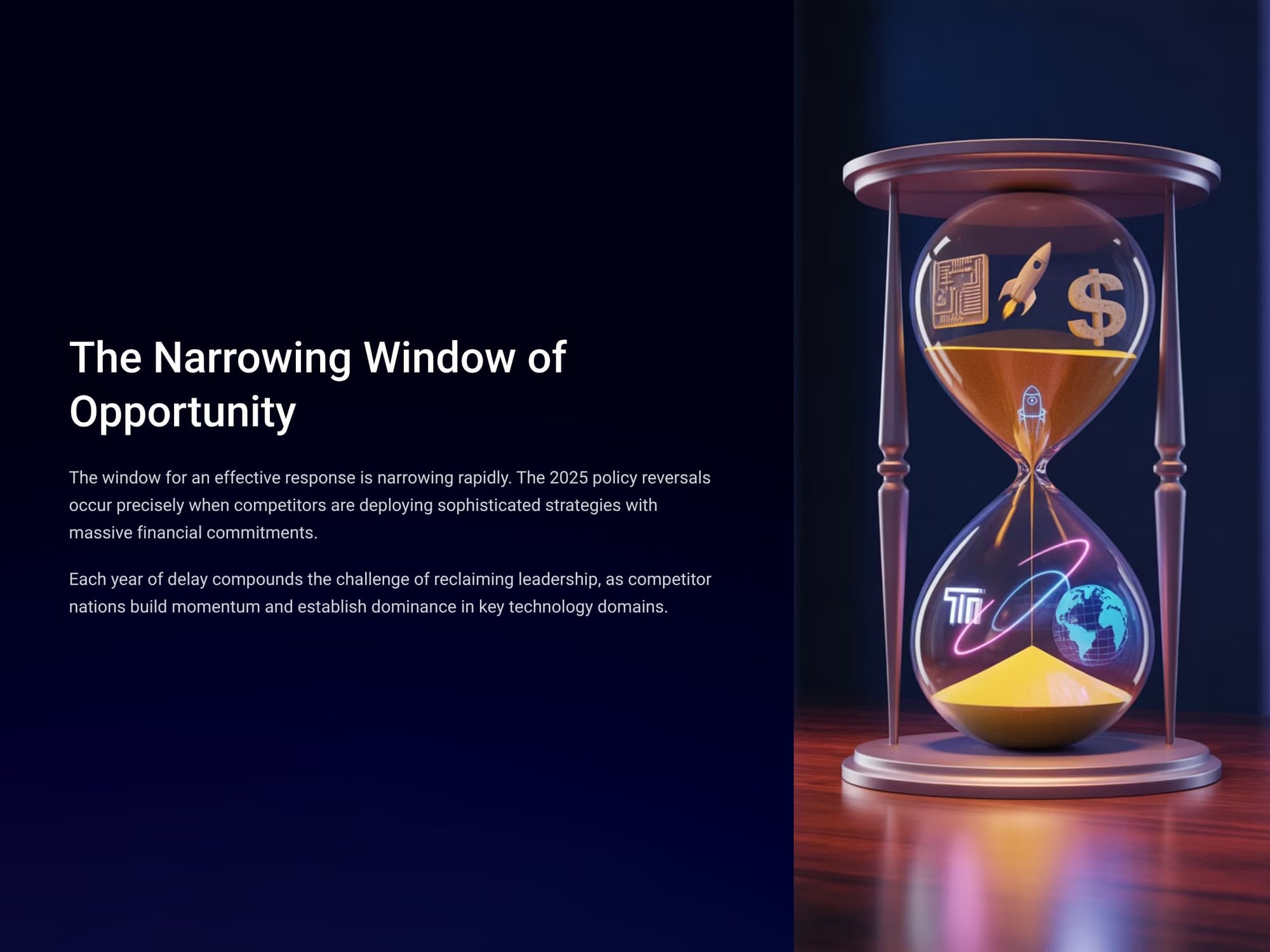
The choice facing America is stark, and the consequences of inaction are profound for the nation's economic prosperity, national security, and global influence. In a nutshell, it could:
- Reverse Course: Implement dramatic policy changes and investments to reclaim innovation leadership.
- Accept Decline: Accept that the era of uncontested American technological leadership is ending, replaced by a more competitive, distributed global innovation system.
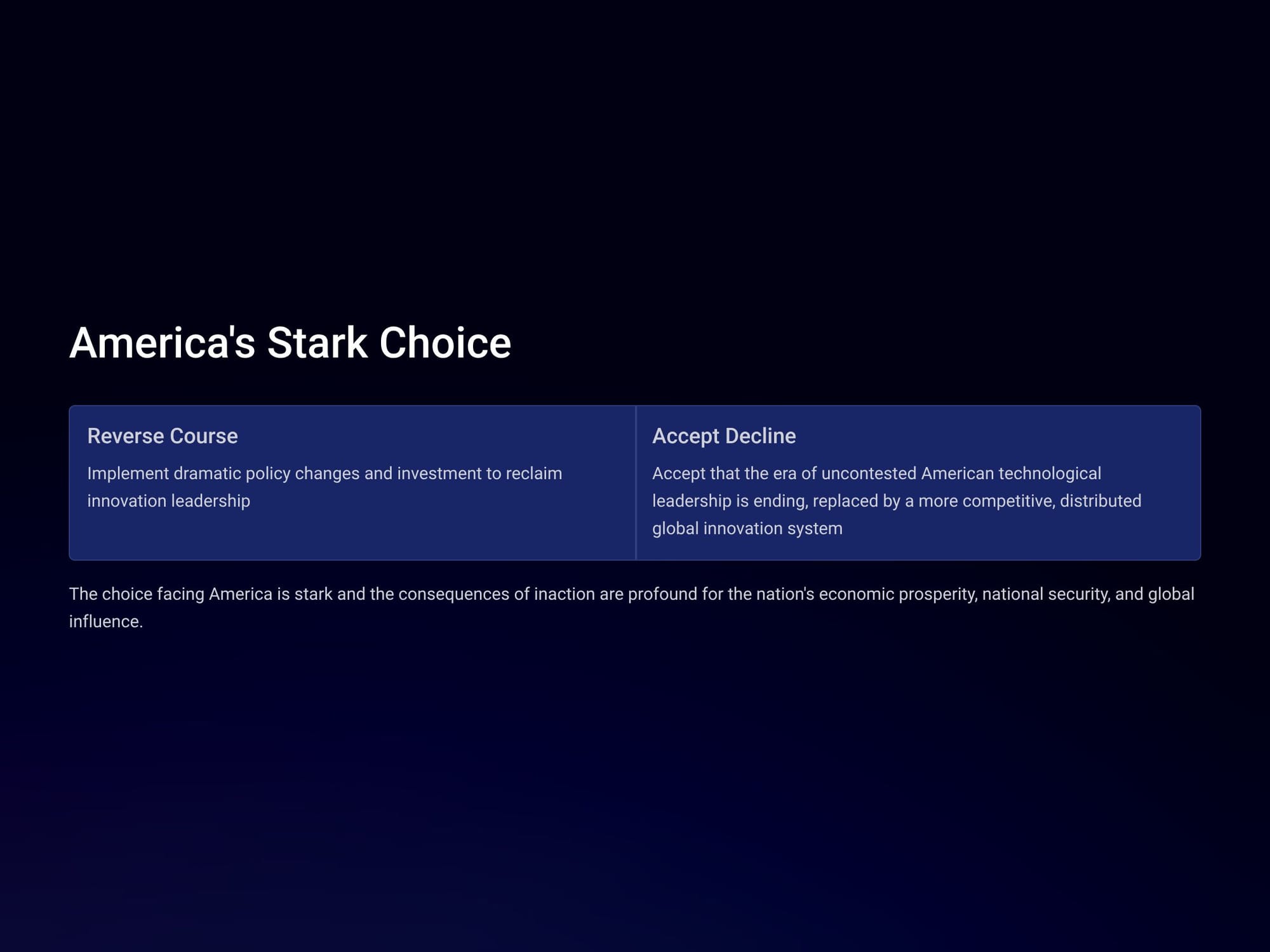
If you listen to the political rhetoric today, it's pretty clear that it is fully accepting the decline.
What does this mean as a Megatrend? For the rest of the world, opportunity!
In any moment of negativity (for the US), the ROTW (reset of the world) sees massive and significant potential, albeit at the same time that it disengages with the increasing unreliability of the US as a business and political partner.
Futurist Jim Carroll covers, obviously, the future. This includes considering the impact of those who choose to turn their backs on it.
Original post

